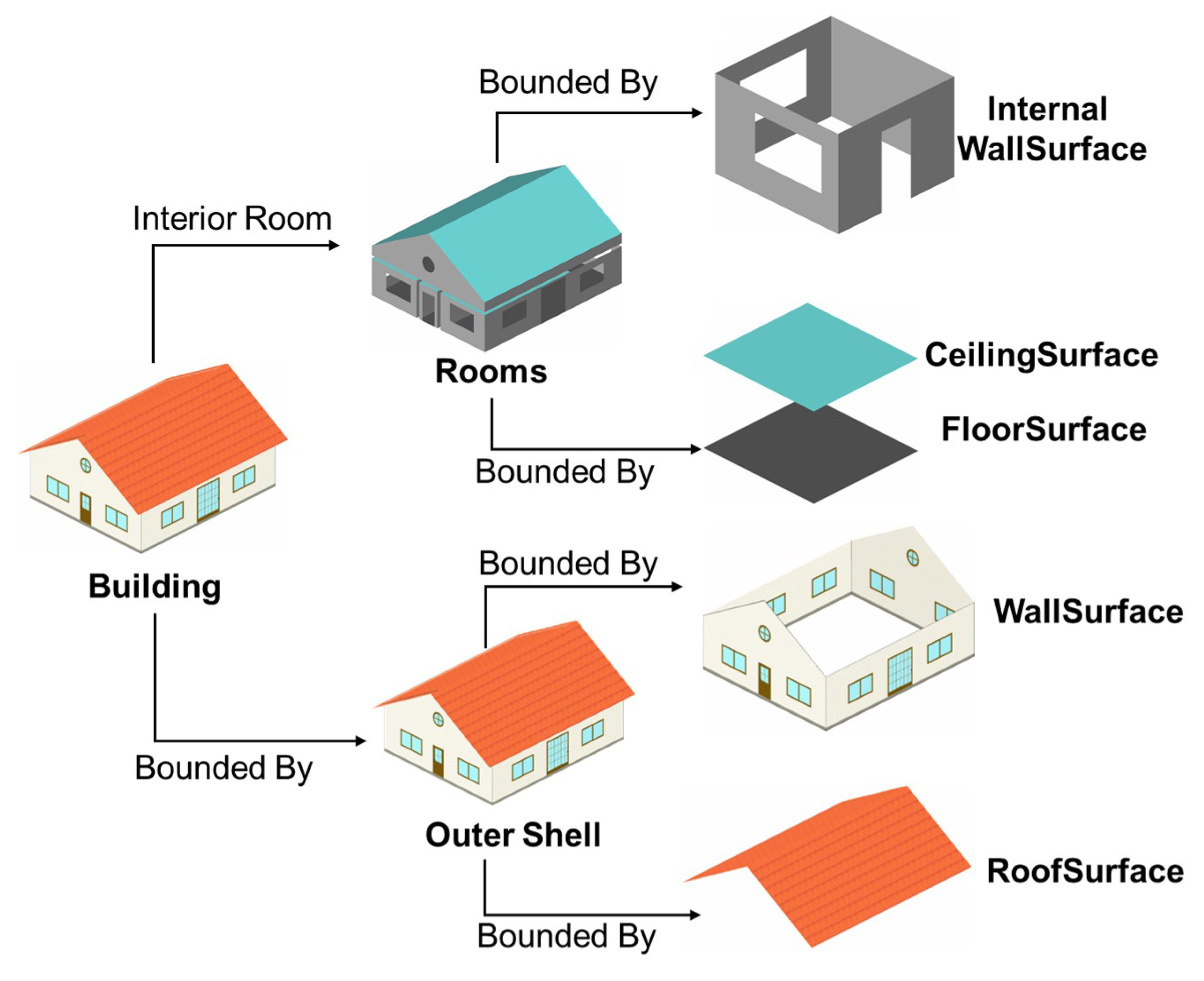Open-Source Tool for Transforming CityGML Levels of Detail
Abstract
:1. Introduction
2. Literature Review
2.1. UBEM and BEM
2.2. Archetype-Based Approach
2.3. State-of-the-Art
2.4. CityGML
2.5. CityGML—Levels of Detail
2.6. CityGML—Application Domain Extensions
2.7. CityGML—Usage and Availability
3. Aim of Research
4. Methodology and Implementation
4.1. Import
4.2. Upscaling from Lower to Higher LoD
4.2.1. Upscaling LoD0 Models
4.2.2. Upscaling LoD1 Models
4.3. Downscaling from Higher to Lower LoD
4.3.1. Downscaling LoD2 Models
4.3.2. Downscaling LoD1 Models
4.4. Optional Inputs
- Building Function: The building function, referring to the actual usage of the building, plays a significant role in analysing the energetic performance of a building. In a bottom-up archetype-based approach, the building function is important to precisely enrich the building models with statistical data. Based on the usage of the building, the occupancy, heating/cooling schedules, etc., are used for simulations. In CityGML, the building function is stored in the bldg:function element and is generally defined with the help of external definable dictionaries known as code lists [66]. In CityLDT, users can input the building function based on the CityGML standard definitions.
- Year of Construction: The bldg:yearOfConstruction element includes the first year of a buildings’ construction. Previously CityGML models representing cities included the years of construction within the open datasets; however, this is now changed as per the analysis made by the authors. This parameter is also important for an archetype-based enrichment. Some cities and municipalities also provide the years of construction of different buildings in separate databases [134]. If available, these could be added to the data models using CityLDT.
- Storeys above/below ground: The storeys above ground refer to the number of above ground floors of a building, whereas the storeys below ground refer to the floors below the ground surface. In CityGML, both of these parameters are stored as individual elements. The storeys above/below ground are important for simulating apartment buildings, multi-family houses and/or terraced houses as they generally consist of more than one floor. This parameter can be added/modified using CityLDT.
4.5. Export
- Only transformed building models: While exporting the transformed building models, the non-transformed buildings are not included in the output. The transformed models are, however, combined and stored as a single dataset for output.
- Transformed and non-transformed models: For exporting both transformed and non-transformed, new datasets can be generated comprising all building models from the input dataset. This might be important for datasets containing both LoD1 and LoD2 together. If required for simulations, the building models in LoD1 can be transformed and combined with the LoD2 models.
- Transformed building into individual CityGML datasets: This option enables the users to store the transformed building models as individual datasets containing one model per dataset.
5. Tool Validation
5.1. Open Data Vienna
5.2. FZK House
5.3. Open Data Hamburg
6. Discussion
7. Conclusions and Future Work
Author Contributions
Funding
Institutional Review Board Statement
Informed Consent Statement
Data Availability Statement
Conflicts of Interest
Abbreviations
| BEPS | Building Energy Performance Simulation |
| UBEM | Urban Building Energy Modelling |
| BEM | Building Energy Modelling |
| HVAC | Heating, Ventilation and Air Conditioning |
| CityGML | City Geographical Markup Language |
| gbXML | Green Building XML |
| ADE | Application Domain Extension |
| LoD | Levels of Detail |
| OGC | Open Geospatial Consortium |
| CityLDT | CityGML LoD Transformation |
| BIM | Building Information Modelling |
| GIS | Geographical Information System |
| IFC | Industry Foundation Classes |
| GUI | Graphical User Interface |
| GML | Geographical Markup Language |
| MB | Megabytes |
References
- United Nations. World Urbanization Prospects 2018; ST/ESA/SER.A/421; United Nations Department for Economic and Social Affairs: New York, NY, USA, 2018; pp. 1–38. [Google Scholar]
- United Nations. Transforming Our World: The 2030 Agenda for Sustainable Development; A/RES/70/1; United Nations, Department of Economic and Social Affairs: New York, NY, USA, 2015; pp. 1–35. [Google Scholar]
- Shan, S.; Genç, S.Y.; Kamran, H.W.; Dinca, G. Role of green technology innovation and renewable energy in carbon neutrality: A sustainable investigation from Turkey. J. Environ. Manag. 2021, 294, 113004. [Google Scholar] [CrossRef] [PubMed]
- Wang, J.A.; Yu, C.; Cao, S.J. Technology pathway of efficient and climate-friendly cooling in buildings: Towards carbon neutrality. Indoor Built Environ. 2021, 30, 1307–1311. [Google Scholar] [CrossRef]
- Da Schio, N.; Brekke, K.F. The relative carbon footprint of cities. In Working Paper du Programme Villes et Territoires; SciencesPO, Observatory of European Institutions: Paris, France, 2013; pp. 1–27. [Google Scholar]
- Gendron, C. Beyond environmental and ecological economics: Proposal for an economic sociology of the environment. Ecol. Econ. 2014, 105, 240–253. [Google Scholar] [CrossRef]
- Bazjanac, V. IFC BIM-Based Methodology for Semi-Automated Building Energy Performance Simulation; Technical Report; Lawrence Berkeley National Lab. (LBNL): Berkeley, CA, USA, 2008. [Google Scholar]
- Crawley, D.B.; Hand, J.W.; Kummert, M.; Griffith, B.T. Contrasting the capabilities of building energy performance simulation programs. Build. Environ. 2008, 43, 661–673. [Google Scholar] [CrossRef] [Green Version]
- Malhotra, A.; Bischof, J.; Nichersu, A.; Häfele, K.H.; Exenberger, J.; Sood, D.; Allan, J.; Frisch, J.; van Treeck, C.; O’Donnell, J.; et al. Information Modelling for Urban Building Energy Simulation—A Taxonomic Review. Build. Environ. 2021. [Google Scholar] [CrossRef]
- Malhotra, A.; Bischof, J.; Allan, J.; O’Donnell, J.; Schwengler, T.; Joachim, B.; Schweiger, G. A Review on Country Specific Data Availability and Acquisition Techniques for City Quarter Information Modelling for Building Energy Analysis. In Proceedings of the BauSIM 2020—8th Conference of IBPSA Germany and Austria, Graz, Austria, 23–25 September 2020; pp. 543–549. [Google Scholar]
- Krarti, M. Chapter 9—Analysis of Large-Scale Energy Efficiency Programs. In Optimal Design and Retrofit of Energy Efficient Buildings, Communities, and Urban Centers; Krarti, M., Ed.; Butterworth-Heinemann: Oxford, UK, 2018; pp. 547–610. [Google Scholar] [CrossRef]
- Ferrando, M.; Causone, F.; Hong, T.; Chen, Y. Urban building energy modeling (UBEM) tools: A state-of-the-art review of bottom-up physics-based approaches. Sustain. Cities Soc. 2020, 62, 102408. [Google Scholar] [CrossRef]
- Chen, Y.; Hong, T.; Luo, X.; Hooper, B. Development of City Buildings Dataset for Urban Building Energy Modeling. Energy Build. 2018, 183, 252–265. [Google Scholar] [CrossRef] [Green Version]
- Hong, T.; Chen, Y.; Luo, X.; Luo, N.; Lee, S.H. Ten questions on urban building energy modeling. Build. Environ. 2020, 168, 106508. [Google Scholar] [CrossRef] [Green Version]
- Liu, X.; Wang, X.; Wright, G.; Cheng, J.C.P.; Li, X.; Liu, R. A State-of-the-Art Review on the Integration of Building Information Modeling (BIM) and Geographic Information System (GIS). ISPRS Int. J. Geoinf. 2017, 6, 53. [Google Scholar] [CrossRef] [Green Version]
- Kolbe, T.H.; Gröger, G.; Plümer, L. CityGML: Interoperable Access to 3D City Models. In Geo-Information for Disaster Management; Springer: Berlin/Heidelberg, Germany, 2005; pp. 883–899. [Google Scholar]
- Li, X.; Wen, J. Review of building energy modeling for control and operation. Renew. Sustain. Energ. Rev. 2014, 37, 517–537. [Google Scholar] [CrossRef]
- Foucquier, A.; Robert, S.; Suard, F.; Stéphan, L.; Jay, A. State of the art in building modelling and energy performances prediction: A review. Renew. Sustain. Energ. Rev. 2013, 23, 272–288. [Google Scholar] [CrossRef] [Green Version]
- Ali, U.; Shamsi, M.H.; Hoare, C.; Mangina, E.; O’Donnell, J. Review of urban building energy modeling (UBEM) approaches, methods and tools using qualitative and quantitative analysis. Energy Build. 2021, 246, 111073. [Google Scholar] [CrossRef]
- Costanzo, V.; Evola, G.; Marletta, L. Urban Heat Stress and Mitigation Solutions: An Engineering Perspective; Routledge: London, UK, 2021. [Google Scholar]
- Cerezo, C.; Sokol, J.; AlKhaled, S.; Reinhart, C.; Al-Mumin, A.; Hajiah, A. Comparison of four building archetype characterization methods in urban building energy modeling (UBEM): A residential case study in Kuwait City. Energy Build. 2017, 154, 321–334. [Google Scholar] [CrossRef]
- Buckley, N.; Mills, G.; Reinhart, C.; Berzolla, Z.M. Using urban building energy modelling (UBEM) to support the new European Union’s Green Deal: Case study of Dublin Ireland. Energy Build. 2021, 247, 111115. [Google Scholar] [CrossRef]
- Swan, L.G.; Ugursal, V.I. Modeling of end-use energy consumption in the residential sector: A review of modeling techniques. Renew. Sustain. Energy Rev. 2009, 13, 1819–1835. [Google Scholar] [CrossRef]
- Johari, F. Urban Building Energy Modeling: A Systematic Evaluation of Modeling and Simulation Approaches. Ph.D. Thesis, Uppsala University, Uppsala, Sweden, 2021. [Google Scholar]
- Kavgic, M.; Mavrogianni, A.; Mumovic, D.; Summerfield, A.; Stevanovic, Z.; Djurovic-Petrovic, M. A review of bottom-up building stock models for energy consumption in the residential sector. Build. Environ. 2010, 45, 1683–1697. [Google Scholar] [CrossRef]
- Hedegaard, R.E.; Kristensen, M.H.; Pedersen, T.H.; Brun, A.; Petersen, S. Bottom-up modelling methodology for urban-scale analysis of residential space heating demand response. Appl. Energy 2019, 242, 181–204. [Google Scholar] [CrossRef]
- Faure, X.; Johansson, T.; Pasichnyi, O. Impacts of the level of details, shadowing and thermal zoning on urban building energy modelling (UBEM) on a district scale. In Proceedings of the 20th European Roundtable on Sustainable Consumption and Production, Graz, Austria, 8–10 September 2021; pp. 133–152. [Google Scholar] [CrossRef]
- Reinhart, C.F.; Cerezo Davila, C. Urban building energy modeling—A review of a nascent field. Build. Environ. 2016, 97, 196–202. [Google Scholar] [CrossRef] [Green Version]
- Cerezo Davila, C.; Reinhart, C.F.; Bemis, J.L. Modeling Boston: A workflow for the efficient generation and maintenance of urban building energy models from existing geospatial datasets. Energy J. 2016, 117, 237–250. [Google Scholar] [CrossRef]
- Langevin, J.; Reyna, J.L.; Ebrahimigharehbaghi, S.; Sandberg, N.; Fennell, P.; Nägeli, C.; Laverge, J.; Delghust, M.; Mata, É.; Van Hove, M.; et al. Developing a common approach for classifying building stock energy models. Renew. Sustain. Energ. Rev. 2020, 133, 110276. [Google Scholar] [CrossRef]
- Romano, P.; Prataviera, E.; Carnieletto, L.; Vivian, J.; Zinzi, M.; Zarrella, A. Assessment of the Urban Heat Island Impact on Building Energy Performance at District Level with the EUReCA Platform. Clim. J. 2021, 9, 48. [Google Scholar] [CrossRef]
- Li, W.; Zhou, Y.; Cetin, K.S.; Yu, S.; Wang, Y.; Liang, B. Developing a landscape of urban building energy use with improved spatiotemporal representations in a cool-humid climate. Build. Environ. 2018, 136, 107–117. [Google Scholar] [CrossRef]
- Gatt, D.; Yousif, C.; Cellura, M.; Camilleri, L.; Guarino, F. Assessment of building energy modelling studies to meet the requirements of the new Energy Performance of Buildings Directive. Renew. Sustain. Energ. Rev. 2020, 127, 109886. [Google Scholar] [CrossRef]
- Nouvel, R.; Brassel, K.H.; Bruse, M.; Duminil, E.; Coors, V.; Eicker, U.; Robinson, D. SimStadt, a new workflow-driven urban energy simulation platform for CityGML city models. In Proceedings of the International Conference CISBAT 2015 Future Buildings and Districts Sustainability from Nano to Urban Scale, LESO-PB, EPFL, Lausanne, Switzerland, 9–11 September 2015; pp. 889–894. [Google Scholar]
- Remmen, P.; Lauster, M.; Mans, M.; Fuchs, M.; Osterhage, T.; Müller, D. TEASER: An open tool for urban energy modelling of building stocks. J. Build. Perform. Simul. 2016, 11, 84–98. [Google Scholar] [CrossRef]
- Sokol, J.; Davila, C.C.; Reinhart, C.F. Validation of a Bayesian-based method for defining residential archetypes in urban building energy models. Energy Build. 2017, 134, 11–24. [Google Scholar] [CrossRef]
- Pasichnyi, O.; Wallin, J.; Kordas, O. Data-driven building archetypes for urban building energy modelling. Energy J. 2019, 181, 360–377. [Google Scholar] [CrossRef]
- Ali, U.; Shamsi, M.H.; Hoare, C.; Mangina, E.; O’Donnell, J. A data-driven approach for multi-scale building archetypes development. Energy Build. 2019, 202, 109364. [Google Scholar] [CrossRef]
- Mohammadiziazi, R.; Copeland, S.; Bilec, M.M. Urban building energy model: Database development, validation, and application for commercial building stock. Energy Build. 2021, 248, 111175. [Google Scholar] [CrossRef]
- Ballarini, I.; Corgnati, S.P.; Corrado, V. Use of reference buildings to assess the energy saving potentials of the residential building stock: The experience of TABULA project. Energy Policy 2014, 68, 273–284. [Google Scholar] [CrossRef]
- Hao, S.; Hong, T. The Application of Urban Building Energy Modeling in Urban Planning. In Rethinking Sustainability towards a Regenerative Economy; Springer: Cham, Switzerland, 2021; pp. 45–63. [Google Scholar]
- Loga, T.; Stein, B.; Diefenbach, N. TABULA building typologies in 20 European countries—Making energy related features of residential building stocks comparable. Energy Build. 2016, 132, 4–12. [Google Scholar] [CrossRef]
- Shimoda, Y.; Fujii, T.; Morikawa, T.; Mizuno, M. Residential end-use energy simulation at city scale. Build. Environ. 2004, 39, 959–967. [Google Scholar] [CrossRef]
- Heiple, S.; Sailor, D.J. Using building energy simulation and geospatial modeling techniques to determine high resolution building sector energy consumption profiles. Energy Build. 2008, 40, 1426–1436. [Google Scholar] [CrossRef] [Green Version]
- Marston, A.; Garforth, P.; Fleichammer, G.; Baumann, O. Urban Scale Modelling–How Generalised Models Can Help Communities Halve Their Energy Use in 30 Years. In Proceedings of the 2014 ASHRAE/IBPSA-USA Building Simulation Conference, Atlanta, GA, USA, 10–12 September 2014. [Google Scholar]
- Mata, É.; Kalagasidis, A.S.; Johnsson, F. Building-stock aggregation through archetype buildings: France, Germany, Spain and the UK. Build. Environ. 2014, 81, 270–282. [Google Scholar] [CrossRef] [Green Version]
- Famuyibo, A.A.; Duffy, A.; Strachan, P. Developing archetypes for domestic dwellings—An Irish case study. Energy Build. 2012, 50, 150–157. [Google Scholar] [CrossRef] [Green Version]
- De Jaeger, I.; Reynders, G.; Saelens, D. Quantifying Uncertainty Propagation For The District Energy Demand Using Realistic Variations On Input Data. In Proceedings of the Building Simulation 2019: 16th Conference of IBPSA, Rome, Italy, 2–4 September 2019; pp. 3636–3643. [Google Scholar] [CrossRef]
- Malhotra, A.; Shamovich, M.; Frisch, J.; van Treeck, C. Parametric Study of the Different Level of Detail of CityGML and Energy-ADE Information for Energy Performance Simulations. In Proceedings of the IBPSA Building Simulation 2019, Rome, Italy, 2–4 September 2019; pp. 3429–3436. [Google Scholar] [CrossRef]
- De Jaeger, I.; Reynders, G.; Callebaut, C.; Saelens, D. A building clustering approach for urban energy simulations. Energy Build. 2020, 208, 109671. [Google Scholar] [CrossRef]
- Jaeger, I.; Reynders, G.; Ma, Y.; Saelens, D. Impact of building geometry description within district energy simulations. Energy J. 2018, 158, 1060–1069. [Google Scholar] [CrossRef]
- Monien, D.; Strzalka, A.; Koukofikis, A.; Coors, V.; Eicker, U. Comparison of building modelling assumptions and methods for urban scale heat demand forecasting. Future Cities Environ. 2017, 3, 2. [Google Scholar] [CrossRef]
- Risch, S.; Remmen, P.; Müller, D. Influence of data acquisition on the Bayesian calibration of urban building energy models. Energy Build. 2021, 230, 110512. [Google Scholar] [CrossRef]
- Zhang, Y.; Bai, X.; Mills, F.P.; Pezzey, J.C. Rethinking the role of occupant behavior in building energy performance: A review. Energy Build. 2018, 172, 279–294. [Google Scholar] [CrossRef]
- Hong, T.; Yan, D.; D’Oca, S.; Chen, C.f. Ten questions concerning occupant behavior in buildings: The big picture. Build. Environ. 2017, 114, 518–530. [Google Scholar] [CrossRef] [Green Version]
- Ding, Y.; Han, S.; Tian, Z.; Yao, J.; Chen, W.; Zhang, Q. Review on occupancy detection and prediction in building simulation. In Building Simulation; Springer: Berlin/Heidelberg, Germany, 2021; pp. 1–24. [Google Scholar]
- Hong, T.; Luo, X. Modeling building energy performance in urban context. In Proceedings of the 2018 Building Performance Analysis Conference and SimBuild Co-Organized by ASHRAE and IBPSA-USA, Chicago, IL, USA, 26–28 September 2018; pp. 26–28. [Google Scholar]
- Quan, S.J.; Li, Q.; Augenbroe, G.; Brown, J.; Yang, P.P.J. Urban data and building energy modeling: A GIS-based urban building energy modeling system using the urban-EPC engine. In Planning Support Systems and Smart Cities; Springer: Berlin/Heidelberg, Germany, 2015; pp. 447–469. [Google Scholar]
- Quan, S.J.; Li, C. Urban form and building energy use: A systematic review of measures, mechanisms, and methodologies. Renew. Sustain. Energ. Rev. 2021, 139, 110662. [Google Scholar] [CrossRef]
- Trepci, E.; Maghelal, P.; Azar, E. Effect of densification and compactness on urban building energy consumption: Case of a Transit-Oriented Development in Dallas, TX. Sustain. Cities Soc. 2020, 56, 101987. [Google Scholar] [CrossRef]
- Buckley, N.; Mills, G.; Letellier-Duchesne, S.; Benis, K. Designing an Energy-Resilient Neighbourhood Using an Urban Building Energy Model. Energies 2021, 14, 4445. [Google Scholar] [CrossRef]
- Lepore, M. Urban microclimate parameters for buildings energy strategies. VITRUVIO-Int. J. Archit. Technol. Sustain. 2016, 1, 1–10. [Google Scholar] [CrossRef]
- Semmo, A.; Trapp, M.; Kyprianidis, J.E.; Döllner, J. Interactive visualization of generalized virtual 3D city models using level-of-abstraction transitions. In Computer Graphics Forum; Wiley Online Library: Hoboken, NJ, USA, 2012; Volume 31, pp. 885–894. [Google Scholar]
- Gröger, G.; Plümer, L. CityGML—Interoperable semantic 3D city models. ISPRS J. Photogram. Remote Sens. 2012, 71, 12–33. [Google Scholar] [CrossRef]
- Würstle, P.; Santhanavanich, T.; Padsala, R.; Coors, V. The Conception of an Urban Energy Dashboard using 3D City Models. In Proceedings of the Eleventh ACM International Conference on Future Energy Systems, Melbourne, Australia, 22–26 June 2020; pp. 523–527. [Google Scholar]
- Gröger, G.; Kolbe, T.H.; Nagel, C.; Häfele, K.H. OGC City Geography Markup Language (CityGML) Encoding Standard, Version: 2.0.0; OGC 12-019, Technical Report; Open Geospatial Consortium: Rockville, MD, USA, 2012. [Google Scholar]
- Häfele, K.H.; Benner, J. STREAMER Deliverable 6.5: Advance Mapping Structures and Standards; Technical Report; Streamer Consortium, 2015; Available online: https://www.streamer-project.eu/Downloads/D6.5.pdf (accessed on 4 December 2021).
- Kutzner, T.; Chaturvedi, K.; Kolbe, T.H. CityGML 3.0: New functions open up new applications. PFG J. Photogramm. Remote Sens. Geoinf. Sci. 2020, 88, 43–61. [Google Scholar] [CrossRef] [Green Version]
- Lu, L.; Becker, T.; Löwner, M.O. 3D complete traffic noise analysis based on CityGML. In Advances in 3D Geoinformation; Springer: Berlin/Heidelberg, Germany, 2017; pp. 265–283. [Google Scholar]
- Tymkow, P.; Karpina, M.; Borkowski, A. 3D GIS for flood modelling in river valleys. Int. Arch. Photogramm. Remote Sens. 2016, 41, 175–178. [Google Scholar] [CrossRef] [Green Version]
- Saran, S.; Wate, P.; Srivastav, S.; Krishna Murthy, Y. CityGML at semantic level for urban energy conservation strategies. Ann. GIS 2015, 21, 27–41. [Google Scholar] [CrossRef]
- Biljecki, F.; Kumar, K.; Nagel, C. CityGML Application Domain Extension (ADE): Overview of developments. Open Geospat. Data Softw. Stand. 2018, 3, 15. [Google Scholar] [CrossRef] [Green Version]
- Malhotra, A.; Frisch, J.; van Treeck, C. Technical Report: Literature Review Concerning IFC, gbXML and CityGML Data Models for Energy Performance Simulation; RWTH Aachen University: Aachen, Germany, 2019. [Google Scholar]
- Agugiaro, G.; Benner, J.; Cipriano, P.; Nouvel, R. The Energy Application Domain Extension for CityGML: Enhancing interoperability for urban energy simulations. Open Geospat. Data Softw. Stand. 2018, 3, 2. [Google Scholar] [CrossRef]
- Kutzner, T.; Kolbe, T.H. Extending Semantic 3D City Models by Supply and Disposal Networks for Analysing the Urban Supply Situation. Lösungen für eine Welt im Wandel, Dreiländertagung der SGPF, DGPF und OVG, 36. Wissenschaftlich-Technische Jahrestagung der DGPF; Deutsche Gesellschaft für Photogrammetrie, Fernerkundung und Geoinformation e.V.: Bern, Switzerland, 2016. [Google Scholar]
- Allacker, K.; Castellani, V.; Baldinelli, G.; Bianchi, F.; Baldassarri, C.; Sala, S. Energy simulation and LCA for macro-scale analysis of eco-innovations in the housing stock. Int. J. Life Cycle Assess. 2019, 24, 989–1008. [Google Scholar] [CrossRef] [Green Version]
- Munoz, E.; Dochev, I.; Seller, H.; Peters, I. Constructing a Synthetic City for Estimating Spatially Disaggregated Heat Demand. Int. J. Microsimul. 2016, 9, 66–88. [Google Scholar]
- Ballarini, I.; Corrado, V. A new methodology for assessing the energy consumption of building stocks. Energies 2017, 10, 1102. [Google Scholar] [CrossRef] [Green Version]
- Frayssinet, L.; Berthou, T.; Duplessis, B.; Kuznik, F.; Hubert, J.-L.; Roux, J.-J.; Claude, U.; Lyon, B.; Umr, C.; Orvanne, L. Incertitude de s imulation à l’échelle du quartier: Comparaison de deux modèles et analyse de sensibilité. In Proceedings of the Conférence IBPSA France, Bordeaux, Italy, 15–16 May 2018; pp. 1–8. [Google Scholar]
- Zheng, Z.; Chen, J.; Luo, X. Parallel computational building-chain model for rapid urban-scale energy simulation. Energy Build. 2019, 201, 37–52. [Google Scholar] [CrossRef]
- Wang, H.; Pan, Y.; Luo, X. Integration of BIM and GIS in sustainable built environment: A review and bibliometric analysis. Autom. Constr. 2019, 103, 41–52. [Google Scholar] [CrossRef]
- Rossknecht, M.; Airaksinen, E. Concept and Evaluation of Heating Demand Prediction Based on 3D City Models and the CityGML Energy ADE—Case Study Helsinki. ISPRS Int. J. Geoinf. 2020, 9, 602. [Google Scholar] [CrossRef]
- Zirak, M.; Royapoor, M.; Gilbert, T. Cross-Platform Energy Modeling for Scalable Urban Energy Simulation: A Case-Study. In Proceedings of the International Conference on Innovative Applied Energy (IAPE 2019), Oxford, UK, 14–15 March 2019; pp. 2–7. [Google Scholar]
- Chatzinikolaou, E.; Pispidikis, I.; Dimopoulou, E. A Semantically Enriched and Web-Based 3D Energy Model Visualization and Retrieval for Smart Building Implementation Using CityGML and Dynamizer ADE. ISPRS Ann. Photogramm. Remote Sens. Spat. Inf. Sci. 2020, VI-4/W1-20, 53–60. [Google Scholar] [CrossRef]
- Krüger, A.; Kolbe, T.H. Building analysis for urban energy planning using key indicators on virtual 3D city models—The energy atlas of Berlin. Int. Arch. Photogramm. Remote Sens. 2012, XXXIX-B2, 145–150. [Google Scholar] [CrossRef] [Green Version]
- Nouvel, R.; Mastrucci, A.; Leopold, U.; Baume, O.; Coors, V.; Eicker, U. Combining GIS-based statistical and engineering urban heat consumption models: Towards a new framework for multi-scale policy support. Energy Build. 2015, 107, 204–212. [Google Scholar] [CrossRef]
- Agugiaro, G. Energy planning tools and CityGML-based 3D virtual city models: Experiences from Trento (Italy). Appl. Geomat. 2016, 8, 41–56. [Google Scholar] [CrossRef]
- Wetter, M.; van Treeck, C.; Hensen, J. New Generation Computational Tools for Building and Community Energy Systems. IEA EBC Annex 60. 2013. Available online: https://scholar.google.com/scholar?hl=en&as_sdt=0%2C5&q=New+generation+computational+tools+for+building+and+community+energy+++systems&btnG= (accessed on 4 December 2021).
- Wetter, M.; Fuchs, M.; Grozman, P.; Helsen, L.; Jorissen, F.; Lauster, M.; Müller, D.; Nytsch-geusen, C.; Picard, D.; Sahlin, P.; et al. IEA EBC Annex 60 Modelica Library—An international collaboration to develop a free open-source model library for buildings and community energy systems. In Proceedings of the BS2015, Hyderabad, India, 7–9 December 2015; pp. 395–402. [Google Scholar]
- Müller, D.; Lauster, M.; Constantin, A.; Fuchs, M.; Remmen, P. AixLib—An open-source Modelica library within the IEA-EBC Annex 60 framework. In Proceedings of the Central European Symposium on Building Physics 2016 and BauSIM 2016, Dresden, Germany, 14–16 September 2016; pp. 3–11. [Google Scholar]
- Jorissen, F.; Reynders, G.; Baetens, R.; Picard, D.; Saelens, D.; Helsen, L. Implementation and Verification of the IDEAS Building Energy Simulation Library. J. Build. Perform. Simul. 2018, 11, 669–688. [Google Scholar] [CrossRef]
- Crawley, D.B.; Lawrie, L.K.; Winkelmann, F.C.; Buhl, W.F.; Huang, Y.; Pedersen, C.O.; Strand, R.K.; Liesen, R.J.; Fisher, D.E.; Witte, M.J.; et al. EnergyPlus: Creating a new-generation building energy simulation program. Energy Build. 2001, 33, 319–331. [Google Scholar] [CrossRef]
- Hong, T.; Piette, M.A.; Chen, Y.; Lee, S.H.; Taylor-Lange, S.C.; Zhang, R.; Sun, K.; Price, P. Commercial Building Energy Saver: An energy retrofit analysis toolkit. Appl. Energy 2015, 159, 298–309. [Google Scholar] [CrossRef] [Green Version]
- Carnieletto, L.; Ferrando, M.; Teso, L.; Sun, K.; Zhang, W.; Causone, F.; Romagnoni, P.; Zarrella, A.; Hong, T. Italian prototype building models for urban scale building performance simulation. Build. Environ. 2021, 192, 107590. [Google Scholar] [CrossRef]
- Rosser, J.F.; Long, G.; Zakhary, S.; Boyd, D.S.; Mao, Y.; Robinson, D. Modelling urban housing stocks for building energy simulation using CityGML EnergyADE. ISPRS Int. J. Geoinf. 2019, 8, 163. [Google Scholar] [CrossRef] [Green Version]
- Robinson, D.; Stone, A. Solar radiation modelling in the urban context. J. Sol. Energy 2004, 77, 295–309. [Google Scholar] [CrossRef]
- Keirstead, J.; Jennings, M.; Sivakumar, A. A review of urban energy system models: Approaches, challenges and opportunities. Renew. Sustain. Energ. Rev. 2012, 16, 3847–3866. [Google Scholar] [CrossRef] [Green Version]
- Braun, R.; Weiler, V.; Zirak, M.; Dobisch, L.; Coors, V.; Eicker, U. Using 3D CityGML models for building simulation applications at district level. In Proceedings of the 2018 IEEE International Conference on Engineering, Technology and Innovation (ICE/ITMC), Stuttgart, Germany, 17–20 June 2018; IEEE: Piscataway, NJ, USA, 2018; pp. 1–8. [Google Scholar]
- SIG3D. CityGML Wiki: Open Data Initiatives. 2019. Available online: https://www.citygmlwiki.org/index.php/Open_Data_Initiatives (accessed on 11 November 2021).
- Federal Office of Topography (Swisstopo). swissBUILDINGS3D 2.0; Federal Office of Topography: Wabern, Germany, 2021. [Google Scholar]
- Technical University of Munich. 2015. Available online: https://www.asg.ed.tum.de/gis/offene-daten/ (accessed on 8 November 2021).
- New York City Department of Information Technology & Telecommunications. NYC 3-D Building Model; City of New York: New York, NY, USA, 2016. [Google Scholar]
- BuildZero. Open City Model. 2019. Available online: https://buildzeroapp.com/ (accessed on 10 November 2021).
- Towards Data Science, J.T.S. Open-Source CityGML 3D Semantical Building Models in 2020. 2020. Available online: https://towardsdatascience.com/tagged/citygml (accessed on 10 November 2021).
- Wysocki, O. Awesome CityGML. 2021. Available online: https://github.com/OloOcki/awesome-citygml (accessed on 8 November 2021).
- Geoportal: Republic of Estonia (Land Board). 3D Data. 2021. Available online: https://geoportaal.maaamet.ee/eng/ (accessed on 9 November 2021).
- Ledoux, H.; Biljecki, F.; Dukai, B.; Kumar, K.; Peters, R.; Stoter, J.; Commandeur, T. 3dfier: Automatic reconstruction of 3D city models. J. Open Source Softw. 2021, 6, 2866. [Google Scholar] [CrossRef]
- Fissore, F.; Pirotti, F. Migration of digital cartography to CityGML; A web-based tool for supporting simple ETL procedures. Int. Arch. Photogramm. Remote Sens. 2018, 42, 193–200. [Google Scholar] [CrossRef] [Green Version]
- Konde, A.; Tauscher, H.; Biljecki, F.; Crawford, J. Floor plans in CityGML. ISPRS Ann. Photogramm. Remote Sens. Spat. Inf. Sci. 2018, 4, 25–32. [Google Scholar] [CrossRef] [Green Version]
- Isikdag, U.; Zlatanova, S. Towards defining a framework for automatic generation of buildings in CityGML using building Information Models. In 3D Geo-Information Sciences; Springer: Berlin/Heidelberg, Germany, 2009; pp. 79–96. [Google Scholar]
- Pepe, M.; Costantino, D.; Alfio, V.S.; Angelini, M.G.; Restuccia Garofalo, A. A CityGML Multiscale Approach for the Conservation and Management of Cultural Heritage: The Case Study of the Old Town of Taranto (Italy). ISPRS Int. J. Geoinf. 2020, 9, 449. [Google Scholar] [CrossRef]
- Aditya, T.; Laksono, D. LOD 1: 3D CityModel for Implementing SmartCity Concept. In Proceedings of the 2017 International Conference on Information Technology, Singapore, 27–29 December 2017; pp. 136–141. [Google Scholar]
- Chen, S.; Zhang, W.; Wong, N.H.; Ignatius, M. Combining CityGML files and data-driven models for microclimate simulations in a tropical city. Build. Environ. 2020, 185, 107314. [Google Scholar] [CrossRef]
- Geiger, A.; Nichersu, A.; Hagenmeyer, V. Sensitivity of input data in building heating energy demand simulation. In Proceedings of the BauSIM 2020, Graz, Austria, 23–25 September 2020. [Google Scholar]
- Fan, H.; Meng, L. Automatic derivation of different levels of detail for 3D buildings modeled by CityGML. In Proceedings of the 24th International Cartography Conference, Santiago, Chile, 15–21 November 2009; pp. 15–21. [Google Scholar]
- Deng, Y.; Cheng, J.C. Automatic transformation of different levels of detail in 3D GIS city models in CityGML. In Architecture and Design: Breakthroughs in Research and Practice; IGI Global: Hershey, PA, USA, 2019; pp. 1350–1370. [Google Scholar]
- Li, S.; Li, W.; Lin, Z.; Yi, S. Method for 3D City Building Continuous Transformation Based on an Improved LOD Topological Data Structure. ISPRS Int. J. Geoinf. 2019, 8, 504. [Google Scholar] [CrossRef] [Green Version]
- Sun, Q.; Zhou, X.; Hou, D. A Simplified CityGML-Based 3D Indoor Space Model for Indoor Applications. Appl. Sci. 2020, 10, 7218. [Google Scholar] [CrossRef]
- Clarivate Analytics. Web of Science. 2017. Available online: https://clarivate.com/webofsciencegroup/solutions/web-of-science/URL (accessed on 4 November 2021).
- Nouvel, R.; Zirak, M.; Dastageeri, H.; Coors, V.; Eicker, U. Urban energy analysis based on 3D city model for national scale applications. In Proceedings of the IBPSA Germany Conference, Aachen, Germany, 22–24 September 2014; Volume 8. [Google Scholar]
- Biljecki, F.; Lim, J.; Crawford, J.; Moraru, D.; Tauscher, H.; Konde, A.; Adouane, K.; Lawrence, S.; Janssen, P.; Stouffs, R. Extending CityGML for IFC-sourced 3D city models. Autom. Constr. 2021, 121, 103440. [Google Scholar] [CrossRef]
- Zadeh, P.A.; Wei, L.; Dee, A.; Pottinger, R.; Staub-French, S. BIM-CityGML data integration for modern urban challenges. J. Inf. Technol. Constr. 2019, 24, 318–340. [Google Scholar]
- Jusuf, S.K.; Mousseau, B.; Godfroid, G.; Soh, J.H.V. Path to an integrated modelling between IFC and CityGML for neighborhood scale modelling. Int. J. Urban Sci. 2017, 1, 25. [Google Scholar] [CrossRef] [Green Version]
- Colucci, E.; De Ruvo, V.; Lingua, A.; Matrone, F.; Rizzo, G. HBIM-GIS integration: From IFC to cityGML standard for damaged cultural heritage in a multiscale 3D GIS. Appl. Sci. 2020, 10, 1356. [Google Scholar] [CrossRef] [Green Version]
- Tauscher, H.; Lim, J.; Stouffs, R. A modular graph transformation rule set for IFC-to-CityGML conversion. Trans. GIS 2021, 25, 261–290. [Google Scholar] [CrossRef]
- Adouane, K.; Stouffs, R.; Janssen, P.; Domer, B. A model-based approach to convert a building BIM-IFC data set model into CityGML. J. Spat. Sci. 2020, 65, 257–280. [Google Scholar] [CrossRef]
- Zhu, J.; Wu, P.; Chen, M.; Kim, M.J.; Wang, X.; Fang, T. Automatically processing IFC clipping representation for BIM and GIS integration at the process level. Appl. Sci. 2020, 10, 2009. [Google Scholar] [CrossRef] [Green Version]
- Donkers, S. Automatic Generation of CityGML LoD3 Building Models from IFC Models. Ph.D. Thesis, Delft University of Technology, Delft, The Netherlands, 2013. [Google Scholar]
- Karlsruhe Institute of Technology (KIT), Institute for Applied Computer Science (IAI). CityGML Example FZK-Haus. 2017. Available online: https://www.citygmlwiki.org/index.php (accessed on 5 July 2021).
- KIT IAI. FZKViewer (6.2). 2021. Available online: https://www.iai.kit.edu/1302.php (accessed on 2 November 2021).
- Special Interest Group 3D. Modeling Guide for 3D Objects—Part 2: Modeling of Buildings (LoD1, LoD2, LoD3). 2013. Available online: https://files.sig3d.org/file/ag-qualitaet/201311_SIG3D_Modeling_Guide_for_3D_Objects_Part_2.pdf (accessed on 4 December 2021).
- Kulhavy, D.; Hung, I.K.; Unger, D.R.; Viegut, R.; Zhang, Y. Measuring Building Height Using Point Cloud Data Derived from Unmanned Aerial System Imagery in an Undergraduate Geospatial Science Course. High. Educ. Stud. 2021, 11, 105–113. [Google Scholar] [CrossRef]
- Malhotra, A.; Raming, S.; Frisch, J.; van Treeck, C. CtyBIT: CityGML Building Interpolation Tool for Energy Performance Simulations. In Proceedings of the 2021 European Conference on Computing in Construction (2021 EC3), Rhodes, Greece, 19–28 July 2021; pp. 245–252. [Google Scholar] [CrossRef]
- inkasPortal—GeoNet Online GmbH: Geoportal Städteregion Aachen. 12 July 2021. Available online: https://www.staedteregion-aachen.de/de/navigation/staedteregion/geoportal (accessed on 17 October 2021).
- Cox, S.; Daisey, P.; Lake, R.; Portele, C.; Whiteside, A. OpenGIS® Geography Markup Language (GML), Version 3.1.1; Project Document: OGC 03-105r1; OGC 12-019; Technical Report; Open Geospatial Consortium: Rockville, MD, USA, 2004. [Google Scholar]
- Biljecki, F.; Ledoux, H.; Stoter, J. An improved LOD specification for 3D building models. Comput. Environ. Urban Syst. 2016, 59, 25–37. [Google Scholar] [CrossRef] [Green Version]
- Agugiaro, G. First steps towards an integrated CityGML-based 3D model of Vienna. ISPRS Ann. Photogramm. Remote Sens. Spat. Inf. Sci. 2016, 3, 139–146. [Google Scholar] [CrossRef] [Green Version]
- Open Data Österreich. Katalog Generalisiertes Dachmodell (LOD2.1) Wien. 2021. Available online: https://www.data.gv.at/ (accessed on 6 November 2021).
- Google Maps. 2021. Available online: https://www.google.com/maps (accessed on 1 November 2021).
- Loga, T.; Diefenbach, N.; Stein, B.; Dascalaki, E.; Balaras, C.; Droutsa, K.; Ignjatovic, D. Typology approach for building stock energy assessment. In Main Results of the TABULA Project. Final Project Report: Appendix Volume; Intelligent Energy Europe, Institut Wohnen und Umwelt: Darmstadt, Germany, 2012. [Google Scholar]
- Mattsson, S.E.; Elmqvist, H.; Otter, M. Physical system modeling with Modelica. Control Eng. Pract. 1998, 6, 501–510. [Google Scholar] [CrossRef]
- Wetter, M.; Zuo, W.; Nouidui, T.S.; Pang, X. Modelica buildings library. J. Build. Perform. Simul. 2014, 7, 253–270. [Google Scholar] [CrossRef]
- Nytsch-Geusen, C.; Huber, J.; Ljubijankic, M.; Rädler, J. Modelica BuildingSystems- eine Modellbibliothek zur Simulation komplexer energietechnischer Gebäudesysteme. Bauphysik 2013, 35, 21–29. [Google Scholar] [CrossRef]
- Dassault Systèmes. Dymola® (Version 2020). 2020. Available online: https://www.3ds.com/products-services/catia/products/dy-mola/ (accessed on 12 December 2020).
- Dempsey, M. Dymola for multi-engineering modelling and simulation. In Proceedings of the 2006 IEEE Vehicle Power and Propulsion Conference, Windsor, UK, 6–8 September 2006; IEEE: Piscataway, NJ, USA, 2006; pp. 1–6. [Google Scholar]
- DWD. Deutscher Wetterdienst. 2017. Available online: https://www.wetterdienst.de/ (accessed on 9 January 2021).
- Behörde für Kultur und Medien. 3D-Stadtmodell LoD1-DE/LoD2-DE Hamburg. 2021. Available online: https://transparenz.hamb-urg.de/ (accessed on 5 July 2021).
- Ebertshäuser, S.; Both, P.; Malhotra, A.; Fichter, E.; Frisch, J.; van Treeck, C.; Nie, Y.; Remmen, P.; Streblow, R.; Müller, D. EnEff-Stadt-ModelSIM: Entwicklung einer Bidirektionalen Schnittstelle zur Modellbasierten Kopplung Kommunaler Planungs-, Simulations- und Analyseprozess; Karlsruher Institut für Technologie (KIT): Karlsruhe, Germany, 2020. [Google Scholar]
- Dochev, I.; Seller, H.; Peters, I. Assigning energetic archetypes to a digital cadastre and estimating building heat demand. An example from Hamburg, Germany. Environ. Clim. Technol. 2020, 24, 233–253. [Google Scholar] [CrossRef]
- Biljecki, F.; Dehbi, Y. Raise the roof: Towards generating LoD2 models without aerial surveys using machine learning. ISPRS Ann. Photogramm. Remote Sens. Spat. Inf. Sci. 2019, 4, 27–34. [Google Scholar] [CrossRef] [Green Version]
- Kolbe, T.H.; Moshrefzadeh, M.; Chaturvedi, K.; Donaubauer, A. The Data Integration Challenge in Smart City Projects; Technical Report; Lehrstuhl für Geoinformatik: München, Germany, 2020. [Google Scholar]
- 3Dis. 3Dis CityEditor. 2020. Available online: https://www.3dis.de/URL (accessed on 3 October 2021).
- Coors, V.; Betz, M.; Duminil, E. A Concept of Quality Management of 3D City Models Supporting Application-Specific Requirements. PFG-J. Photogramm. Remote Sens. Geoinf. Sci. 2020, 88, 3–14. [Google Scholar] [CrossRef] [Green Version]
- Galdosinc. Galdos CityGML Inspector. 2020. Available online: https://www.galdosinc.com/ (accessed on 3 March 2021).
- Malhotra, A.; Shamovich, M.; Frisch, J.; van Treeck, C. Urban Energy Simulations using Open CityGML Models: A Comparative Analysis. Energy Build. 2021, 111658. [Google Scholar] [CrossRef]
- Malhotra, A.; Raming, S.; Frisch, J.; van Treeck, C. CityATB (CGML ATB): CityGML Analysis Toolbox for Energy Performance Simulations. In Proceedings of the BauSIM2020: 8th Conference of IBPSA Germany and Austria, IBPSA, Graz, Austria, 23–25 September 2020; pp. 194–201. [Google Scholar] [CrossRef]
- Benner, J. GML Toolbox. 2020. Available online: https://www.iai.kit.edu/english/1650.php (accessed on 2 March 2021).
- Safe Software Inc. FME Software Copyright (c); Safe Software Inc.: Surrey, BC, Canada, 2019. [Google Scholar]
- Biljecki, F.; Chew, L.Z.X.; Milojevic-Dupont, N.; Creutzig, F. Open government geospatial data on buildings for planning sustainable and resilient cities. arXiv 2021, arXiv:2107.04023. [Google Scholar]
- Moos, N.; Juergens, C.; Redecker, A.P. Geo-Spatial Analysis of Population Density and Annual Income to Identify Large-Scale Socio-Demographic Disparities. ISPRS Int. J. Geoinf. 2021, 10, 432. [Google Scholar] [CrossRef]
- JetBrains. PyCharm 2020.1.1. 2020. Available online: https://www.jetbrains.com/ (accessed on 5 March 2020).
- Microsoft. Visual Studio Code 1.62.3. 2020. Available online: https://code.visualstudio.com/ (accessed on 9 March 2020).
- Krietemeyer, B.; El Kontar, R. A method for integrating an UBEM with GIS for spatiotemporal visualization and analysis. In Proceedings of the 10th Annual Symposium on Simulation for Architecture and Urban Design Conference SimAUD, Atlanta, GA, USA, 7–9 April 2019; pp. 87–94. [Google Scholar]
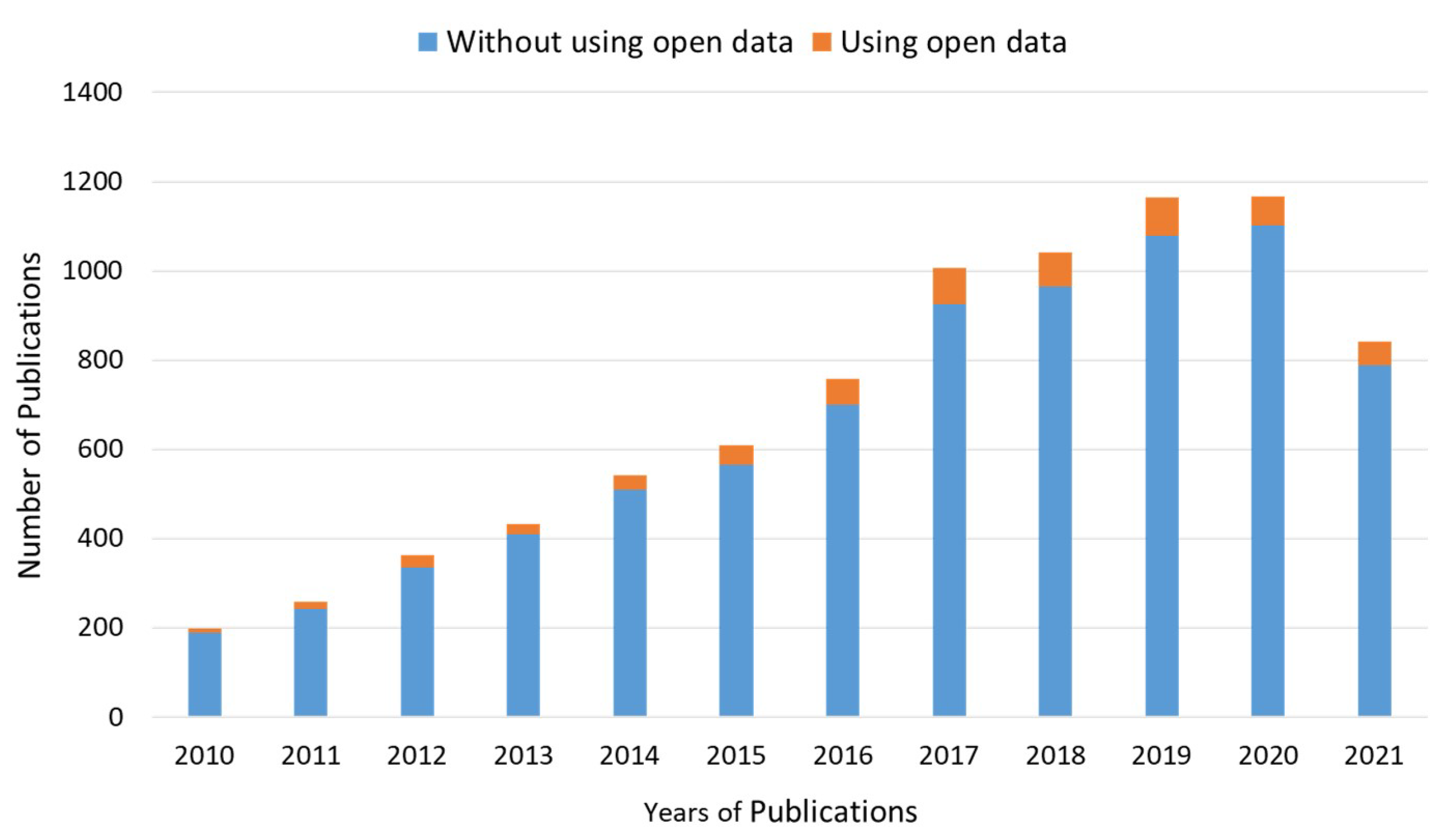
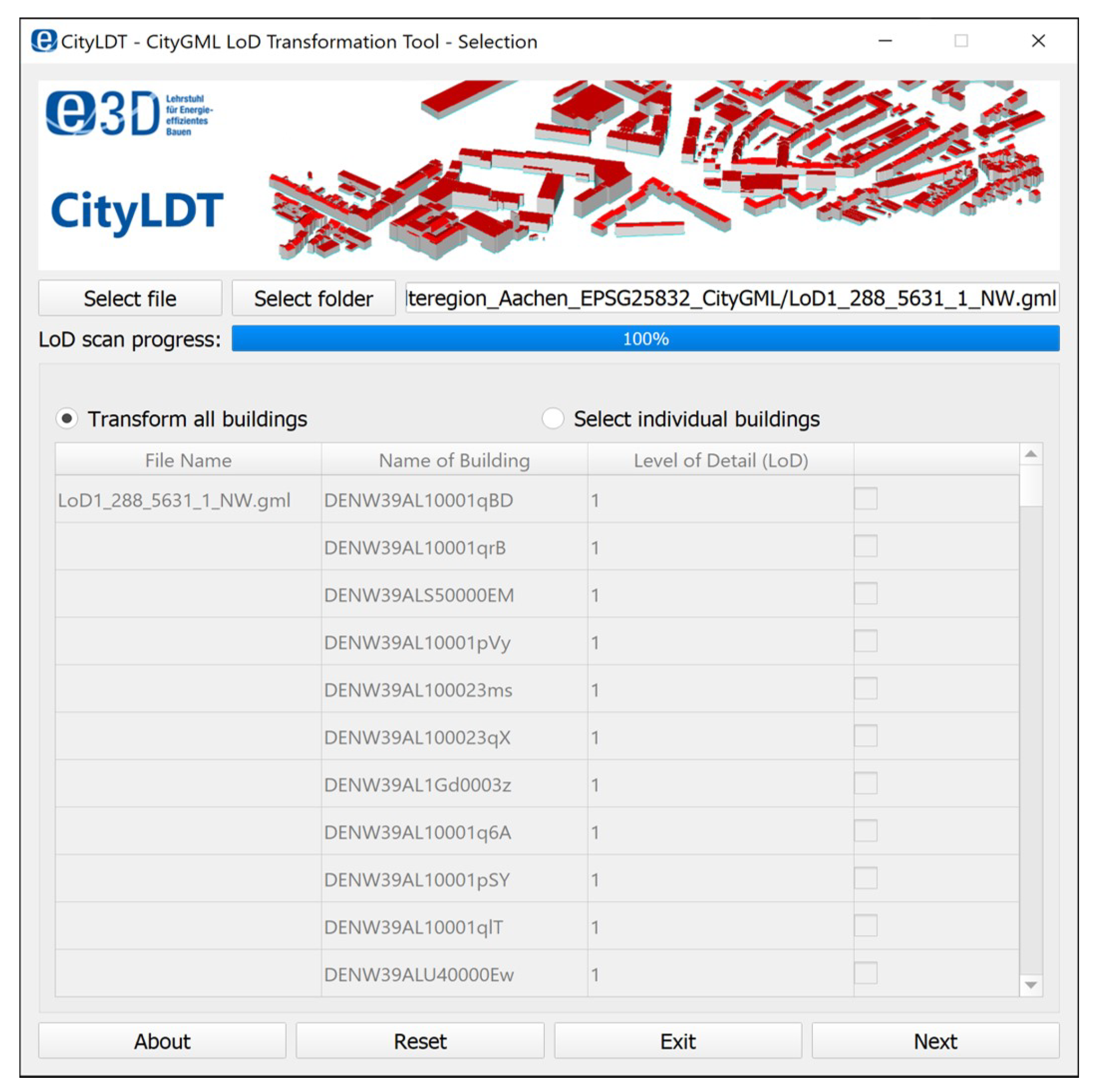

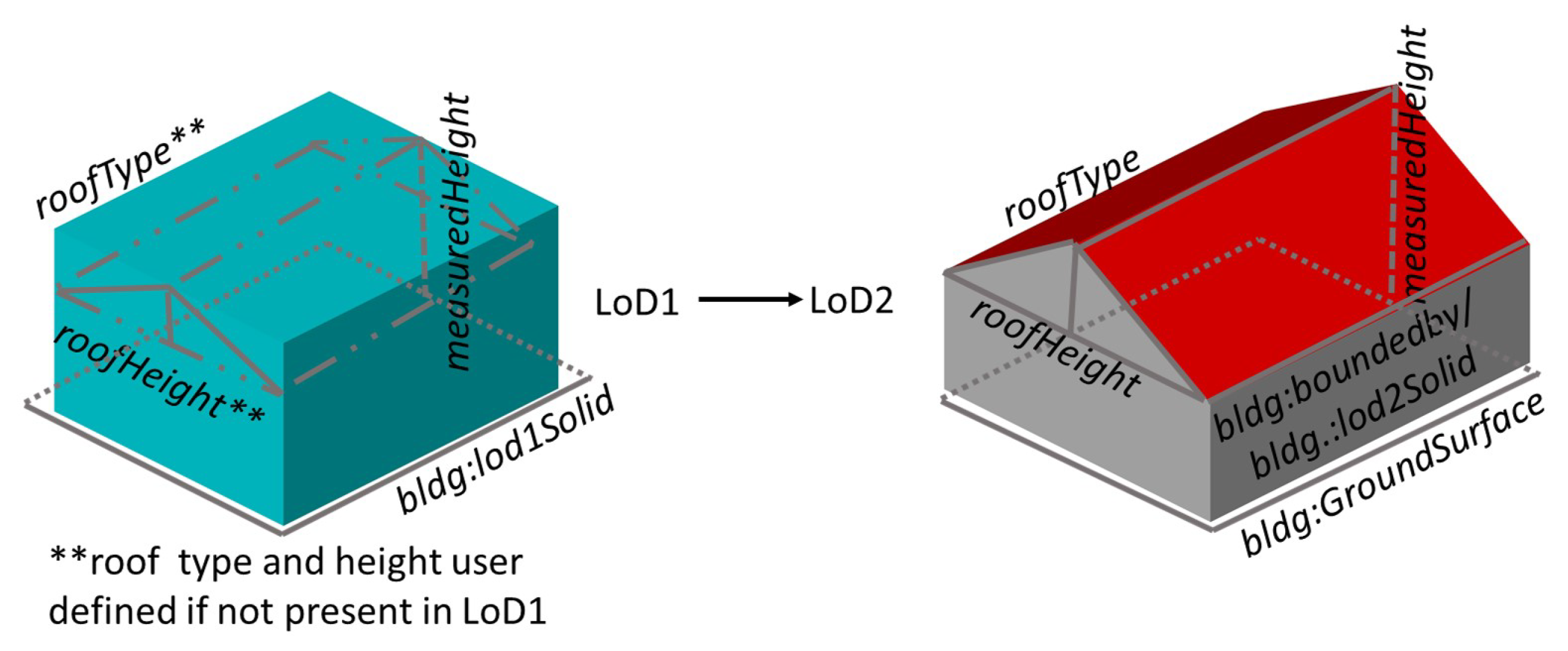
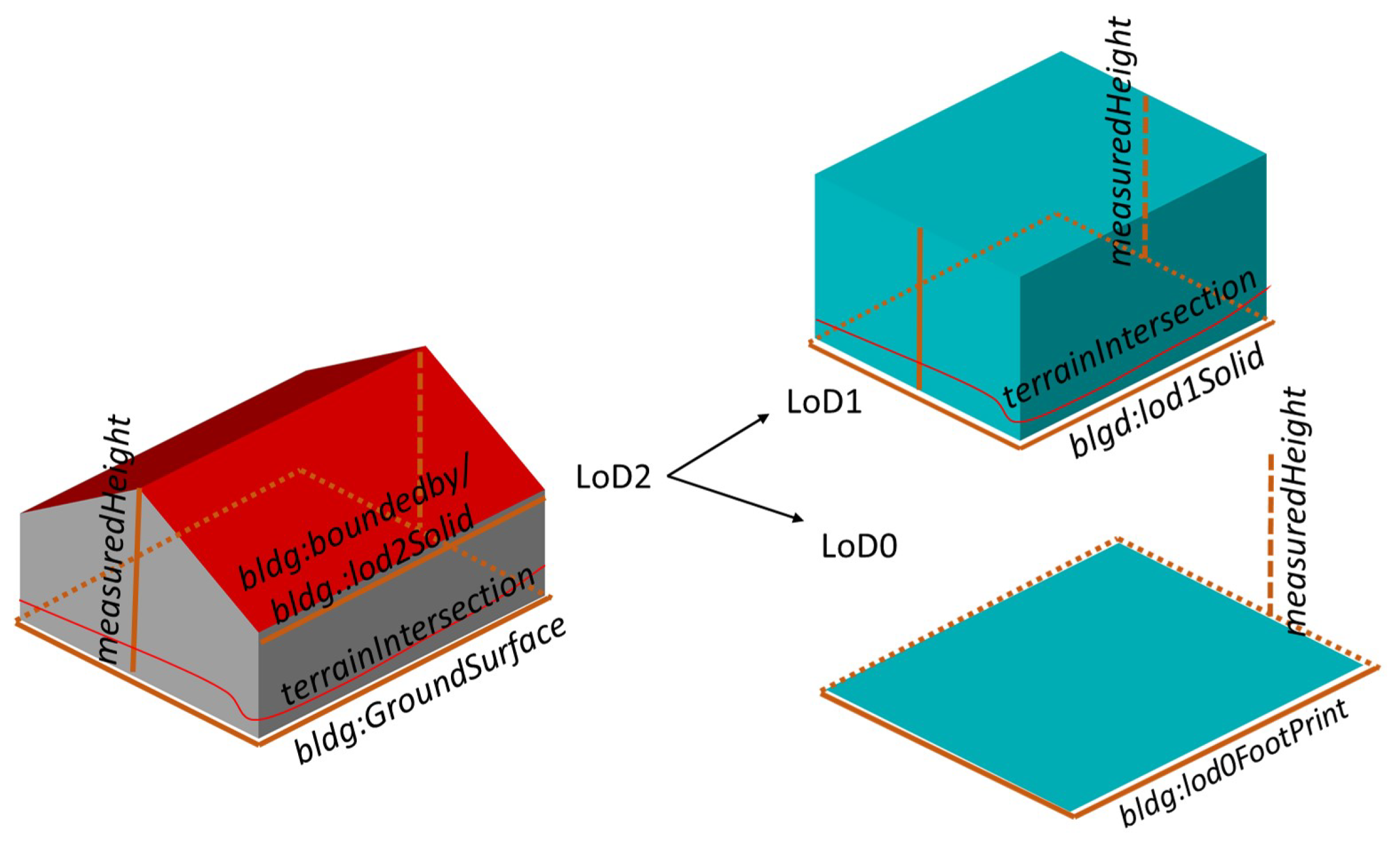
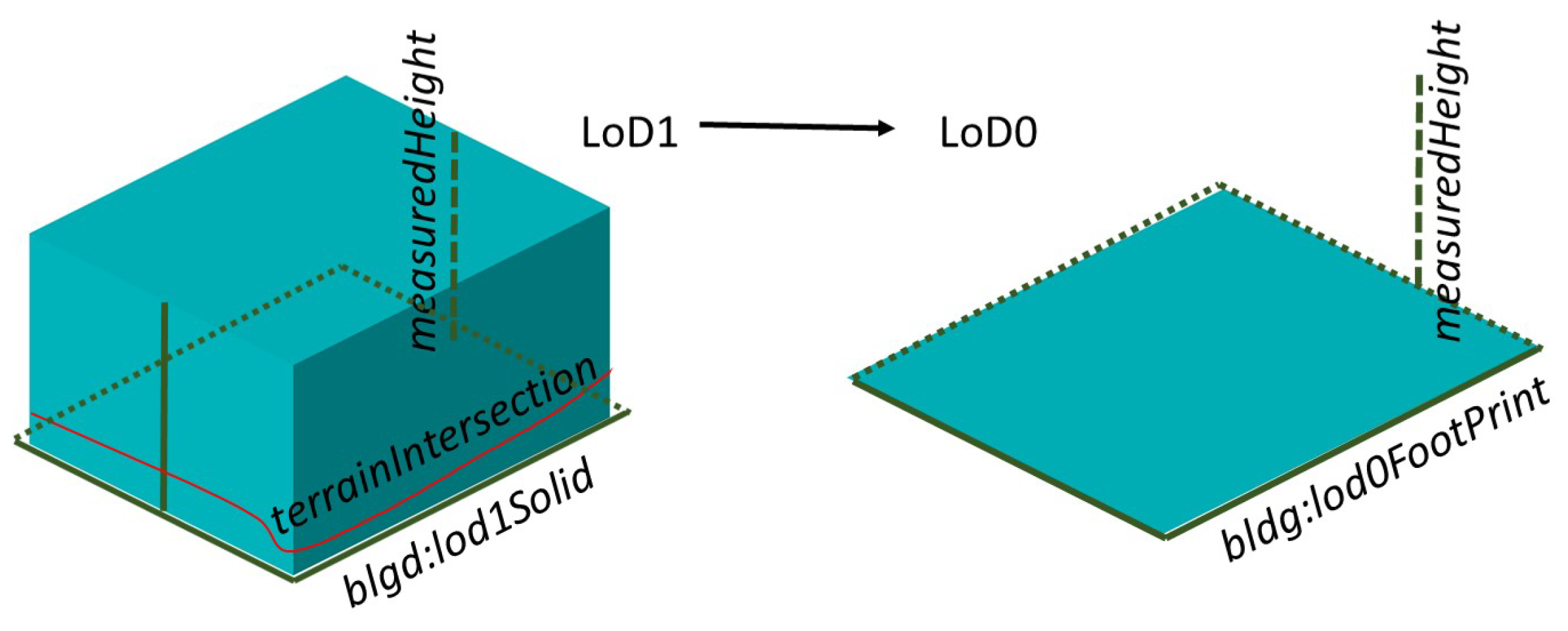


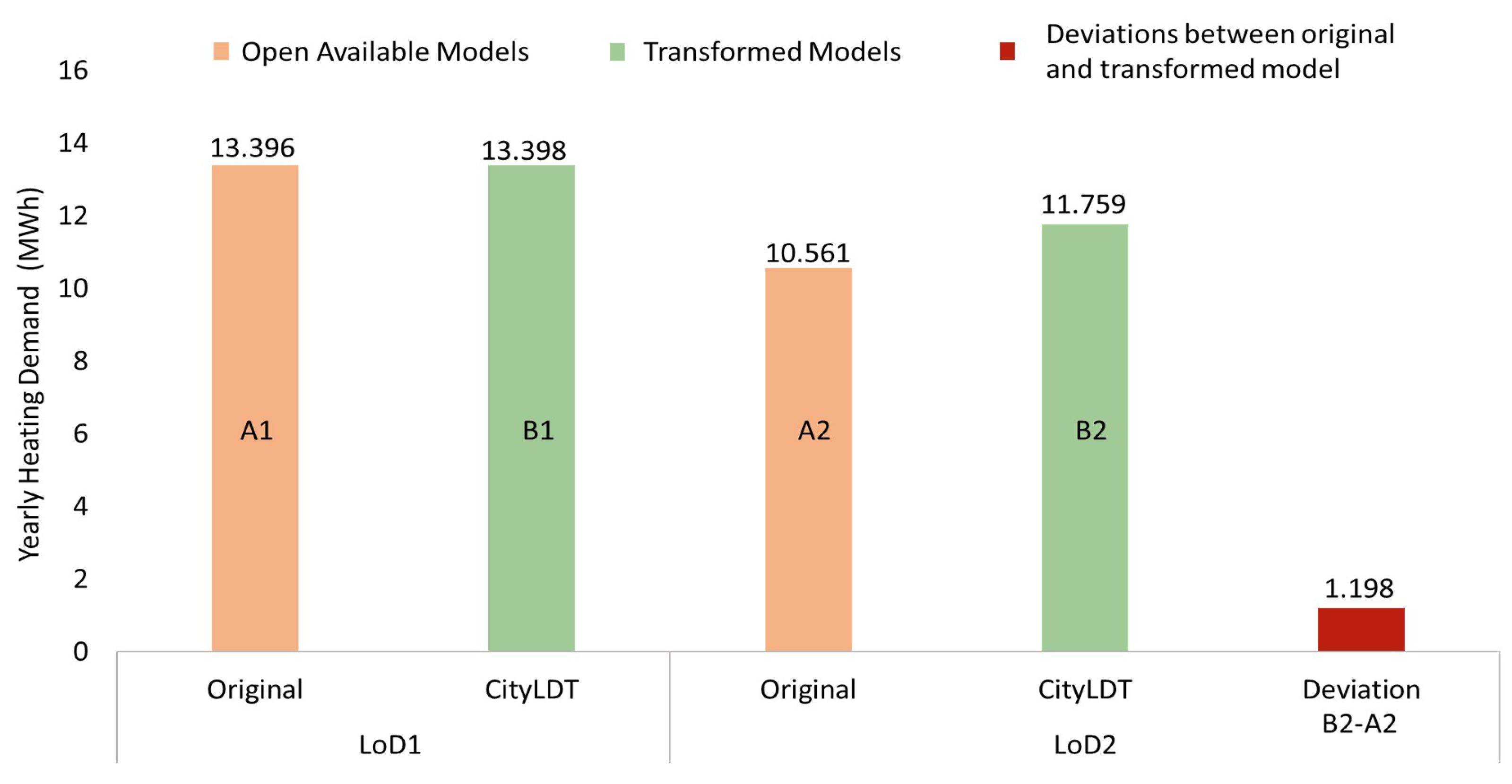


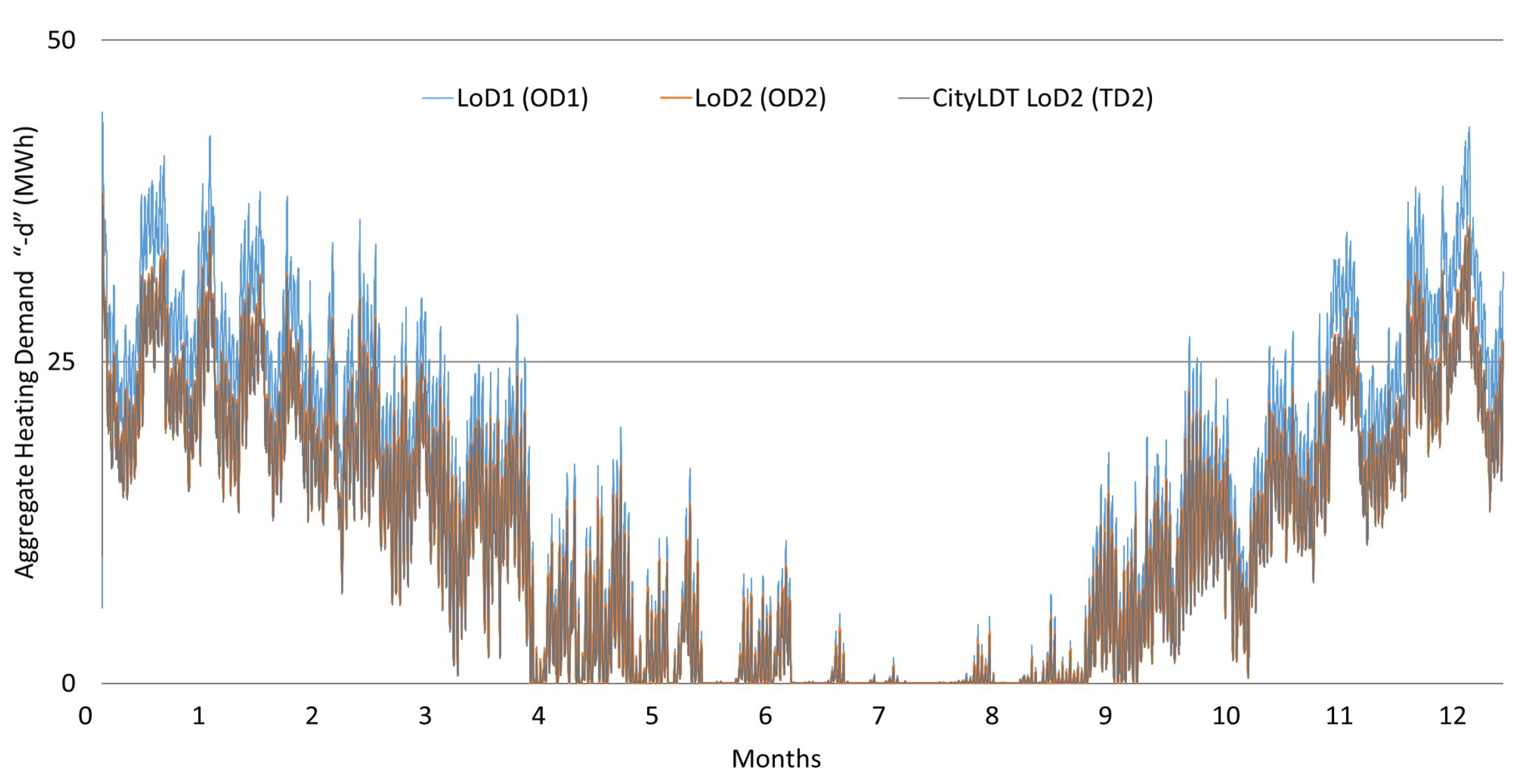

| Country | City/State | LoD | Year |
|---|---|---|---|
| Australia | Adelaide | 1 & 2 | 2020 |
| Melbourne | 1 & 2 | - | |
| Austria | Linz | 2 | 2011 |
| Vienna | 1 & 2 | 2016 | |
| Belgium | Brussels | 2 | 2014 |
| Canada | Montrèal | 2 | 2009 |
| Estonia | Estonia | 1 & 2 | 2021 |
| Finland | Helsinki | 1 & 2 | 2013 |
| Espoo | 1, 2 & 3 | 2013 | |
| France | Lyon | 2 | 2012 |
| Bordeaux | 1, 2 | 2019 | |
| Germany | Berlin | 2 | 2019 |
| Brandenburg | 1 & 2 | 2020 | |
| Hamburg | 1 & 2 | 2020 | |
| Hannover | 1 & 2 | 2019 | |
| Ingolstadt | 3 | 2021 | |
| Niedersachsen | 1 & 2 | 2019 | |
| Nordrhein-Westfalen | 1 & 2 | 2020 | |
| Postdam | 2 | 2017 | |
| Sachsen | 1 & 2 | 2020 | |
| Thüringen | 1 & 2 | 2019 | |
| Ireland | Dublin | 2 | 2018 |
| Japan | Hokota | 1 >2 | 2013 |
| Iwaki | 1 >2 | 2020 | |
| Kiryu | 1 >2 | 2020 | |
| Koriyama | 1 >2 | 2020 | |
| Utsunomiya | 1 >2 | 2020 | |
| Sapporo | 1 >2 | 2020 | |
| Shirakawa | 1 >2 | 2020 | |
| Tokyo | 1 >2 | 2020 | |
| Netherlands | Amsterdam 1 | 1 | - |
| Delft 1 | 1 | - | |
| Leiden 1 | 1 | - | |
| Zwolle 1 | 1 | - | |
| Den Haag | 2 | 2013 | |
| Rotterdam | 1 & 2 | 2020 | |
| Poland | All | 1 | 2019 |
| Switzerland | Zürich | 1 & 2 | 2019 |
| Switzerland in 3D 2,3 | 2 | 2013–2019 | |
| UK | Cambridge | 1 | 2021 |
| London | 1 & 2 | - | |
| USA | New York 4,5 | 1 & 2 | 2019 |
| BuildZero Open City Model 6 | 1 | 2019 |
Publisher’s Note: MDPI stays neutral with regard to jurisdictional claims in published maps and institutional affiliations. |
© 2021 by the authors. Licensee MDPI, Basel, Switzerland. This article is an open access article distributed under the terms and conditions of the Creative Commons Attribution (CC BY) license (https://creativecommons.org/licenses/by/4.0/).
Share and Cite
Malhotra, A.; Raming, S.; Frisch, J.; van Treeck, C. Open-Source Tool for Transforming CityGML Levels of Detail. Energies 2021, 14, 8250. https://doi.org/10.3390/en14248250
Malhotra A, Raming S, Frisch J, van Treeck C. Open-Source Tool for Transforming CityGML Levels of Detail. Energies. 2021; 14(24):8250. https://doi.org/10.3390/en14248250
Chicago/Turabian StyleMalhotra, Avichal, Simon Raming, Jérôme Frisch, and Christoph van Treeck. 2021. "Open-Source Tool for Transforming CityGML Levels of Detail" Energies 14, no. 24: 8250. https://doi.org/10.3390/en14248250
APA StyleMalhotra, A., Raming, S., Frisch, J., & van Treeck, C. (2021). Open-Source Tool for Transforming CityGML Levels of Detail. Energies, 14(24), 8250. https://doi.org/10.3390/en14248250






